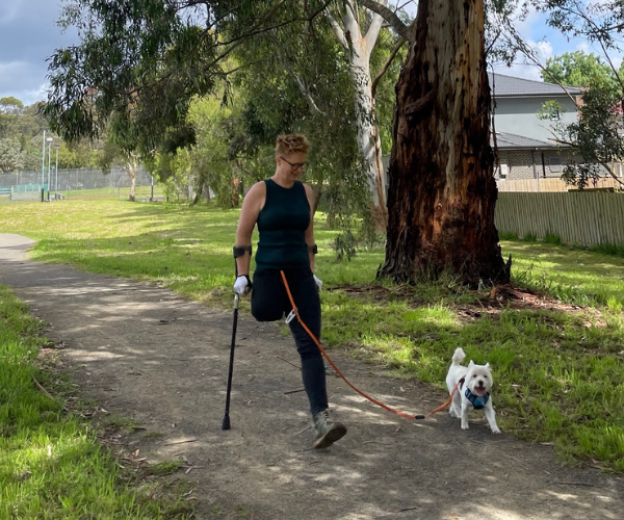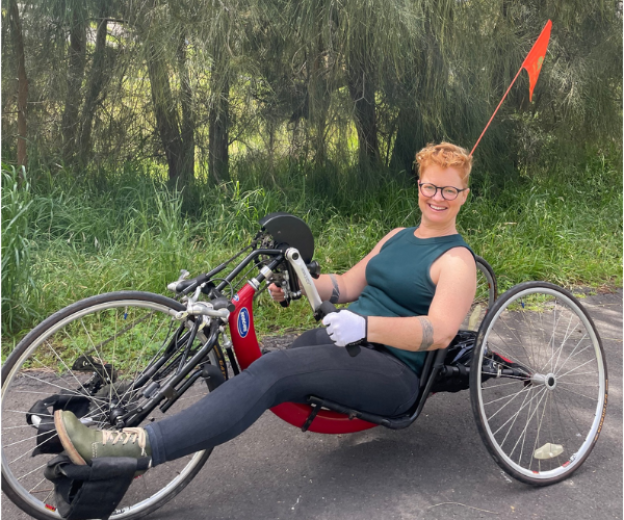- Home
- |
- About us
- |
- News and Events
- |
- Resources
- |
- Contact
- |
- Donate today
- Shop

‘It’s just a pulled muscle’ I thought. I massaged the sore spot with menthol cream and then visited the local pool to blast it with the warm spa jets. That should do it. But it didn’t, and within a few weeks the pain had worsened, a lump was now visible, and it was time to see my doctor. A mere 3 days later, after x-rays and a referral to an orthopaedic surgeon, I was in hospital undergoing scans and biopsies to confirm a diagnosis of osteosarcoma (bone cancer). It was 1987, I was 17 years old, and at the starting point of a journey that would forever change the way I moved through life.
How I moved as a young person was intrinsic to my identity. As a child I was always active whether it was climbing trees, hanging upside-down and spinning from monkey-bars, sprinting in athletics, or challenging myself in gymnastics. My parents laughed that my speed was either ‘one hundred or zero’, nothing in between. My greatest love, however, was dancing. I did ballet as a child but as a teenager I loved to disappear into my room, turn up the volume on my music and allow my body to express the feelings that arose in response to music. Dancing was the language of my soul.
In hospital I endured three months of gut-purging chemotherapy, which successfully stopped the growth of the cancer, but then also had my right leg amputated above the knee as a definitive action to save my life.
Thankfully the doctors and my parents allowed me to make this final decision. A new bone radium and reconstruction treatment was offered to save my leg, but this wasn’t guaranteed to work as it was still experimental, and it meant that I would have spent months in hospital. Honestly by that stage I just wanted the leg gone so I could get out of hospital and get back to my life. After the amputation I spent eight months in rehabilitation to regain my weight and strength, and to learn to walk on my prosthesis. It was at least six months into rehab that the psychological impact of the loss of my leg began to dawn on me, but amidst the intense focus of regaining mobility I decided that the loss of my ability to run and dance was too overwhelming to think about. So, I unconsciously buried those thoughts for the next 20 years in order to I get on with the task of living.

I spent at least five years trying to use my prosthesis, but due to the high amputation which made walking difficult, and issues with skin welts and changing stump size, I decided that I’d rather be pain-free and unburdened by an appendage that made me feel more disabled. The prosthesis got thrown under the bed where it gathered dust while life moved on rapidly, as it does when you are young. By the time I was 25 I was married and raising two baby girls born a year apart. When I was pregnant with my first baby, I finally conceded that a wheelchair would be useful, and once I sat in it, I wondered why I’d waited so long. With the babies at home, I used a combination of crutches and wheelchair for mobility but used my chair if I wanted to take the girls out to a shopping centre. I would push myself in my wheelchair with my left leg stretched out and my foot tucked into the back of their side-by-side twin pram to push them along. We drew attention of course, but it got us out and about. A wheelchair tip for parenting is not to rest a baby on your shoulder and attempt to go backwards down a hallway – it doesn’t end well for anyone.
Another tumour was detected in my 40s and although it was resolved with surgery, it brought a tsunami of fears, and I wondered if this was my fate – to just keep getting cancer until it ended my life. I saw a psychologist for several months and thankfully attended to some of the unresolved fears remaining from when I was younger.
Another daughter was born, and I realised that I really wanted to use my experiences to help others. My experience with cancer and the familiarity around hospitals prompted me to study at the Peter MacCallum Cancer Centre to train as a pastoral carer/chaplain. These skills led me to work in public hospitals throughout Melbourne’s eastern suburbs supporting patients and families though major health crises and very often at the end of their or their loved one’s lives. The work was reciprocally life-giving and meaningful. I am now training as a counsellor to continue to support people make sense of difficulties and find ways that empower them to live better lives. I marvel at the infinitely different ways we humans respond to events in our lives, and even more so, how we find meaning and hope amidst these challenges.
Over the years I’ve continued to participate in many physical activities on one leg such as water-skiing, hiking, synchronised swimming (like dancing, but in water!), swimming, rafting, camping, bike-riding, yoga and going to the gym. But what about the dancing? One day a friend invited me to a creative dance class, and although I couldn’t believe he was asking me, he must have known something, for this began a period of exploring movement again, letting go of old expectations, and re-learning the new language of my body as it is now. I eventually joined an inclusive dance group in Melbourne and danced with them for about four years, even performing in White Night Melbourne and in the Fringe Festival. In this creative environment I was surrounded by people of all shapes, sizes and disabilities and I learned that our differences are our strengths. Whether dancing on crutches or in my wheelchair, I reconnected with my love of music and expressive movement and through these activities began a new and more accepting relationship with my body.
As I get older, the effects of living one-legged are becoming more apparent and I am constantly balancing activity and injury management – though I’m sure I’m not alone here. To take care of myself I utilise a massage therapist, physiotherapist and chiropractor as needed, and invest in specially designed crutches that have rotating tips and shock absorbers to reduce the strain on my joints.
I swim, walk my dog and now handcycle regularly both for physical fitness and because it makes me happy. I have learned to validate and value my needs and to search for the solutions that suit me. I have developed compassion, respect and endearment towards this body that has adapted marvellously and carried me through many challenges. I am grateful for balance, strength and resilience and equally thankful for peace, compassion and acceptance.
Keep up to date with our latest news, events and information